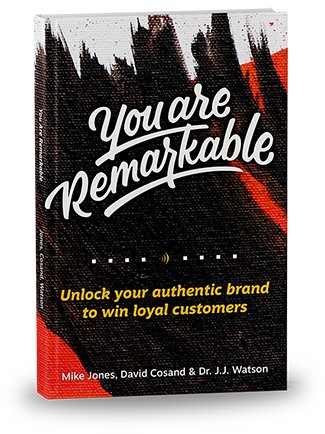Podcast: Play in new window | Download
Subscribe: RSS
Bold vision separates the active from the passive, the fine-tuned brand from the scattered brand.
Had he not imagined sailing into the warm waters of a faraway port on the Indian coastline, Christopher Columbus probably wouldn’t have made the two-month slog across the Atlantic Ocean four times.
But while bold visions can enrapture us and bring some motivation to the inevitable long haul, they don’t account for everything.
Rather, visions sail toward reality (or in Columbus’s class, toward a different continent than the one he had in mind) on the shoulders of clear values, concrete goals, and an overriding purpose that answers the question ‘why.’
A Recap:
In last month’s article, I talked all about how remarkable organizations like yours have a unique identity, a frequency that can be fine-tuned and shared with the world. I also talked about how finding that frequency starts with asking ‘why?’
Why sell cars, insurance, or ice cream?
Why risk everything to open up a direct trade route to India?
Answering the question ‘why’ means following the clues to a clear, motivating vision of how you want the world to be. If you’ve done the hard work of getting that far, you’re getting close to unlocking an authentic brand identity that will resonate with your team, your clients, and those who need you as you really are.
Read on as I walk through:
Beat three: Letting your Purpose define your Values
Beat four: Letting your Values create your Vision
And lastly,
Beat five: Letting your Vision set your Goals
Starting with Values
Once you’ve identified your purpose and your why, it’s time to move on to your values.
Your values are the things you care about, the things that matter to you, and motivate you.
A value isn’t just something you happen to like or appreciate. You might like egg salad, but unless it’s the last sealed lunch on a stranded spaceship… you surely don’t value egg salad. A value is something that you value for its own sake, and other things have value in light of those higher values.
An authentic value is something you’re willing to make sacrifices for. A parent values their children: that means they’ll sacrifice sleep, money, and free time for their sake. The things you sacrifice other things for are what you value most.
When it comes right down to it, values are what ultimately determine your ethical stance as a company. The principles or rules you lay down, along with the boundaries and lines you’re not willing to cross, are things you establish to help you keep and promote your values. The kind of character traits, qualities, and decision-making you want your team to develop are all things you base on your underlying values.
So what does your company value?
Speed? Accuracy? Customer service?
Suppose your company values speed.
If that’s your value, then you’re going to make decisions to try to maximize speed, decisions which another organization might not make. A different company might value, say, being thorough, but if that’s also one of your values, you won’t sacrifice accuracy for speed—but you will make the choice to be more methodical.
Small companies often don’t explicitly state their values, because they’re inferred from the founder or leader: the company values whatever the person in charge values. Over time—and assuming the founder isn’t always around to course-correct—values become a navigational tool for exploring new, uncharted waters, and for bringing new people on board. New employees encounter them in the interview process. Discerning values and making them explicit is part of the natural process of growth.
What we’ve found, however, is that, while most established companies have a set of values, their stated values don’t really express their distinctive purpose.
Instead, laziness leads companies to copy values from other companies, or to pick the most basic value which everybody can agree on, go-to phrases like: “We value integrity and honesty!” or “We value getting the job right the first time!”.
Obvious Values Aren’t Distinctives
But unless you’re in an industry marked by cheating, deception, or sloppy work, then those aren’t distinctive values. If everybody in your industry follows those values, then claiming them as your values is just telling your team what they should already know.
Instead, ask yourself: what would someone else in your industry not be able to claim as a value?
For instance, many companies say they value “customer service”.
Now, if you work in an industry where most others don’t value customer service (like that glorious branch of state bureaucracy that deals in motor vehicles), then that is a distinctive value.
On the other hand, if you are in the hospitality industry, you better value customer service. At some point, “customer service” isn’t a fundamental value to your identity, it’s simply a fundamental part of doing business in your industry.
Distinctive and Authentic Values
When you’re doing a values exercise, and trying to figure out the distinctive values of your company, look closely at your basic beliefs, your why, and your purpose.
What do you value in light of that purpose?
You value customer service, but why? What is it that you value especially, that leads you to value customer service? Can you apply that value to every stakeholder in your organization?
When you say you value “customer service”, realize that it actually only applies to one stakeholder group, and that’s your customers. Is there something more fundamental than customer service that could apply to your customers, your employees, your vendors, and all your shareholders?
What do you believe is valuable about people?
If it helps, consider writing out the “easy” values on the whiteboard first—customer service, honesty, making money, or so on. Acknowledge them and get them out of the way, so you can move beyond that.
An authentic value is something you sincerely believe in. If you can’t say you “believe in” that thing, it isn’t really a core value.
If you get them right, then your values should be what makes people excited enough to get out of bed in the morning and show up to work. They should be what your customers respect and share, what shapes interactions, and permeates the whole of your company, from day to day operations to the overarching vision.
Aiming Higher
An organization’s leadership is responsible for its vision. By a “vision”, we mean not merely a set of plans or hopes for the next five years, but a picture of the world as it would be if the organization’s purpose were fulfilled and its values upheld.
If your company achieved its purpose, and if your company practiced its values consistently… what would that look like? What would that feel like?
And what difference would it make?
A good vision has to be bigger than your own company; it’s not that your company reaches a certain size, hires a certain number of employees, or wins a certain award. Rather, a good vision comes from imagining your purpose and values finally becoming reality.
If your purpose is to help people chill out by serving them ice cream at a rest stop, then your vision might include growth—there are, after all, many rest stops, and many drivers who need to eat ice cream. But the look and feel of relaxed people who are finally taking a break is your vision, not your growth in ice cream sales.
Long-haul Fulfillment
Presenting a vision is helping people see and feel that scenario, where a segment of the world has been remade or repaired because your purpose was achieved.
The job of leadership is to make that picture of a different world seem appealing and achievable, and not just a fantasy. The vision has to feel inspiring and also humanly possible.
A vision is usually best thought of in terms of decades rather than years. Not what you presently are capable of achieving as a company, but the impact you hope to have as you develop and grow over time. You may not have much control about when, whether, or how your vision is achieved… but it’s what you want your present work to ultimately result in.
A vision is like your purpose and values in that it is part of the “roots” of your brand’s “tree,” something that should endure and last through seasons of heavy rains and droughts.
Translating your vision into something you actually have the power to bring about is the process of setting goals.
Value-driven Action
Goals are solid steps that we can take in order to achieve our purpose and act on our values within a limited time frame. Goals work towards the ultimate vision, but they also need to operate within the constraints imposed by limited resources, people, and time.
For instance, if your vision is a world in which people enjoy driving, then related goals might be things like improving the handling on next year’s model, or eliminating road noise in the cabin within five years.
How to set realistic goals is another subject.
But what I want to emphasize here is only that your vision, purpose, and values should drive your goals, rather than the other way around.
Goals should be centered and focused in your brand. They should be built up from your authentic identity; you can’t construct an authentic identity around your current goals.
Basing Everything on Your Core Vision
Companies that try to define their brand based on their current goals rather than on their broader vision find themselves with temporary goals.
They achieve them, or not, and either way, they’re done.
If your brand is based on your current goals or tactics, the brand won’t endure.
It is important for your brand to be aware of your current goals, because even while these shouldn’t change your brand identity, they do influence the optics and communication of your current brand expression. A company can have enduring values and vision, but still need to redesign its logo as its concrete goals change.
What shouldn’t change is its core identity.
Whatever process you use for determining your business’s goals, is it filtered through your values and purpose?
Ask yourself, “Why are we making this a goal?”
Can you articulate how your goal is in service to your purpose? Or are your goals coming from short-term distractions? Before you determine your goals and write up your tasks, take a deep breath and reflect on your values and your vision.
You might make a ritual of starting every strategy session by reviewing your values and purpose. You might make sure that your team members give feedback on how well you’re advancing in your own values.
Likewise, when you look back at what goals you accomplished over the year, you can evaluate those twelve months in terms of how well they promoted your values.
Fine-tune Your Brand
The five ‘beats’ make a handy tool for uncovering your organization’s authentic brand identity.
They’re a basic guide to figuring out your organization’s why, purpose, values, vision, and goals. Granted, these can be pretty abstract, and hard to translate into specific actions or choices. After getting this far, most organizations need some tools to define their brand in a creative, expressive, and visually compelling way.
At Resound, we call this “fine-tuning” a brand, and it gets us more excited than stopping for rest stop ice cream.
If you’ve got a decent idea of your core vision and subsequent values, and if you need some help working towards a look, voice, and online presence that reflects how remarkable you are, then we’re delighted to help.
Give us a call, check out our catalog of online resources, or consider subscribing to our monthly newsletter for more branding wisdom right in your inbox.
We love helping B2B’s and organizations like yours fine-tune their remarkable frequency… and share it with the world.



